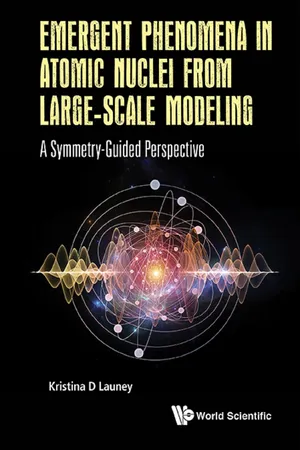
Emergent Phenomena In Atomic Nuclei From Large-scale Modeling: A Symmetry-guided Perspective
A Symmetry-Guided Perspective
- 392 pages
- English
- ePUB (mobile friendly)
- Available on iOS & Android
Emergent Phenomena In Atomic Nuclei From Large-scale Modeling: A Symmetry-guided Perspective
A Symmetry-Guided Perspective
About This Book
-->
This book is a unique collection of reviews that share a common topic, emergent phenomena in atomic nuclei, while revealing the multifaceted nature of the subject, from quarks to heavy nuclei. It tells an amazing story of a decades-long journey of trials and successes, up to present days, with the aim to understand the vast array of experimental data and the fundamentals of strongly interacting fermions. The emphasis is on discovering emergent orderly patterns amidst the overarching complexity of many-particle quantum-mechanical systems. Recent findings are discussed within an interesting framework: a combination of nuclear theory and experiment, of group theory and computational science, and of pivotal models of astonishing simplicity and state-of-the-art models empowered by supercomputers.
A special theme resonates throughout the book: the important role of symmetries, exact and approximate, in exposing emergent features and guiding large-scale nuclear modeling. World-renowned experts offer their unique perspective on symmetries in the world of quarks and gluons, and that of protons and neurons — from chiral symmetry, through spin-isospin and quasi-spin symmetries, to symplectic symmetry, — as well as on the emergent nature of nuclear collectivity, clustering, and pairing, viewed from spectroscopy, microscopic considerations, and first principles. The book provides an excellent foundation that allows researchers and graduate students in physics and applied mathematics to review the current status of the subject, and to further explore the research literature through exhaustive sets of references that also point to studies underpinned by similar techniques in condensed matter and atomic physics along with quantum information.
--> Contents:
- Symmetries in Nuclei: From Experimental Signatures to Pivotal Nuclear Models (Overview):
- Nuclear Collectivity — Its Emergent Nature Viewed from Phenomenology and Spectroscopy (John L Wood)
- The Anatomy of Atomic Nuclei: Illuminating Many-Body Wave Functions Through Group-Theoretical Decomposition (Calvin W Johnson)
- Emergent Simplicity within Intricate Multi-Particle Dynamics: Nuclear Structure and Reactions:
- The Emergence and Use of Symmetry in the Many-Nucleon Model of Atomic Nuclei (David J Rowe)
- Toward Large-Scale Multi-Shell Calculations with Symmetry-Adapted Bases: Lessons From the Symplectic Shell Model (Jutta E Escher)
- Orderly Patterns from First Principles:
- Lattice Quantum Chromodynamics: Symmetries and Applications (Thomas Luu and Andrea Shindler)
- Ab Initio Lattice Effective Field Theory and Wigner's SU(4) Symmetry (Dean Lee)
- Clustering in Light Nuclei with the Correlated Gaussian Approach (Yasuyuki Suzuki and Wataru Horiuchi)
- Symmetry-Adapted No-Core Shell Model — The Ab Initio Picture of Nuclear Collectivity (Jerry P Draayer, Tomas Dytrych and Kristina D Launey)
- Symmetries and Emergent Features in Medium-Mass and Heavy Nuclei:
- Auxiliary-Field Quantum Monte Carlo Methods in Nuclei (Yoram Alhassid)
- Lie Density Functional Theory (George Rosensteel)
- xactly Solvable Pairing in a Mean-Field Framework: Models and Applications (Feng Pan, Xin Guan and Jerry P Draayer)
--> -->
Readership: Graduate students and researchers in nuclear physics.
-->Emergent Phenomena in Atomic Nuclei;Large-Scale Modeling;First Principles;Physically Relevant Symmetries;Nuclear Structure;Nuclear Reactions;Experimental Monopole Moments and Quadrupole Moments;Spectroscopy;Nuclear Collectivity;Large Deformation;Rotations;Clustering;Alpha Clusters;Pairing Gaps;Shape Coexistence;Hoyle State;Giant Resonances;U(1)_A Anomaly in QCD;Neutron Electric Dipole Moment;Electroweak Response Functions;Soft Dipole Mode;Electron Scattering;Light-Ion Scattering;Level Densities;Spin Distribution;Chaotic Behavior;Moment of Inertia;Mathematical Proof of Extended Hohenberg–Kohn Theorem;Lanczos Numerical Algorithm for Eigenvalues;Symplectic Symmetry;Chiral Symmetry;Point Symmetries;Wigner Supermultiplet;Quasi-Spin;SU(3);Sp(3,R);SU(4);Symmetry-Adapted No-Core Shell Model;Lattice Quantum Chromodynamics;Lattice Effective Field Theory;Symplectic Shell Model;Cluster Model;Correlated Gaussian Approach;Auxiliary-Field Quantum Monte Carlo;Exactly Solvable Pairing Model;Density Functional Theory;Light Nuclei;Medium-Mass Nuclei;Heavy Nuclei Key Features:
- Presents the latest status on the topic from a broad range of perspectives and is a unique collection of topics, including overview, historical developments (both in theory and experiment), together with findings of recent state-of-the-art large-scale models
- Each review provides sufficient details to introduce the reader to the subject and capture his/her interest, together with an exhaustive set of references for further exploration of the research literature. References also point to studies that utilize similar techniques in other fields
- Provides an excellent foundation that encompasses not only various emergent features in nuclei, from light to heavy, but also covers few-body systems and clusters, and even further, links to the underlying physics, quarks and gluons
- Contributors are highly respected experts in their fields, have won national and international awards and recognitions, as well as come from leading institutions in countries, such as USA, Canada, Germany, Japan, and China — J Wood, D Rowe, Y Alhassid, Y Suzuki, J Draayer, D Lee, C Johnson, J Escher, T Luu, A Shindler, G Rosensteel, F Pan, W Horiuchi, T Dytrych, and X Guan
Frequently asked questions
Information
Table of contents
- Cover
- Halftitle
- Title
- Copyright
- Preface
- Contents
- Part 1: Symmetries in Nuclei: From Experimental Signatures to Pivotal Nuclear Models (Overview)
- Part 2: Emergent Simplicity within Intricate Multi-particle Dynamics: Nuclear Structure and Reactions
- Part 3 Orderly Patterns from First Principles
- Part 4: Symmetries and Emergent Features in Medium-mass and Heavy Nuclei
- Author Index
- Subject Index